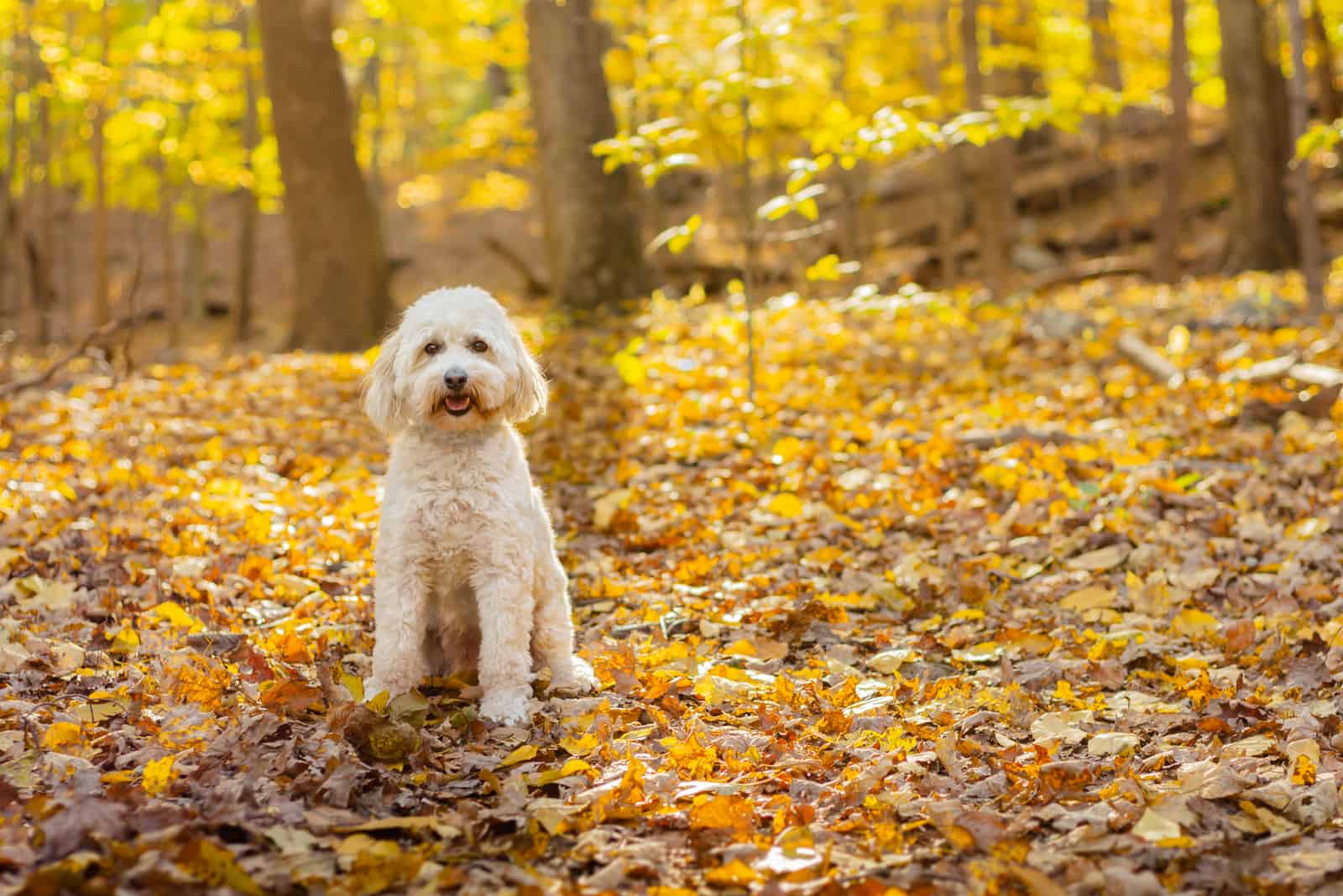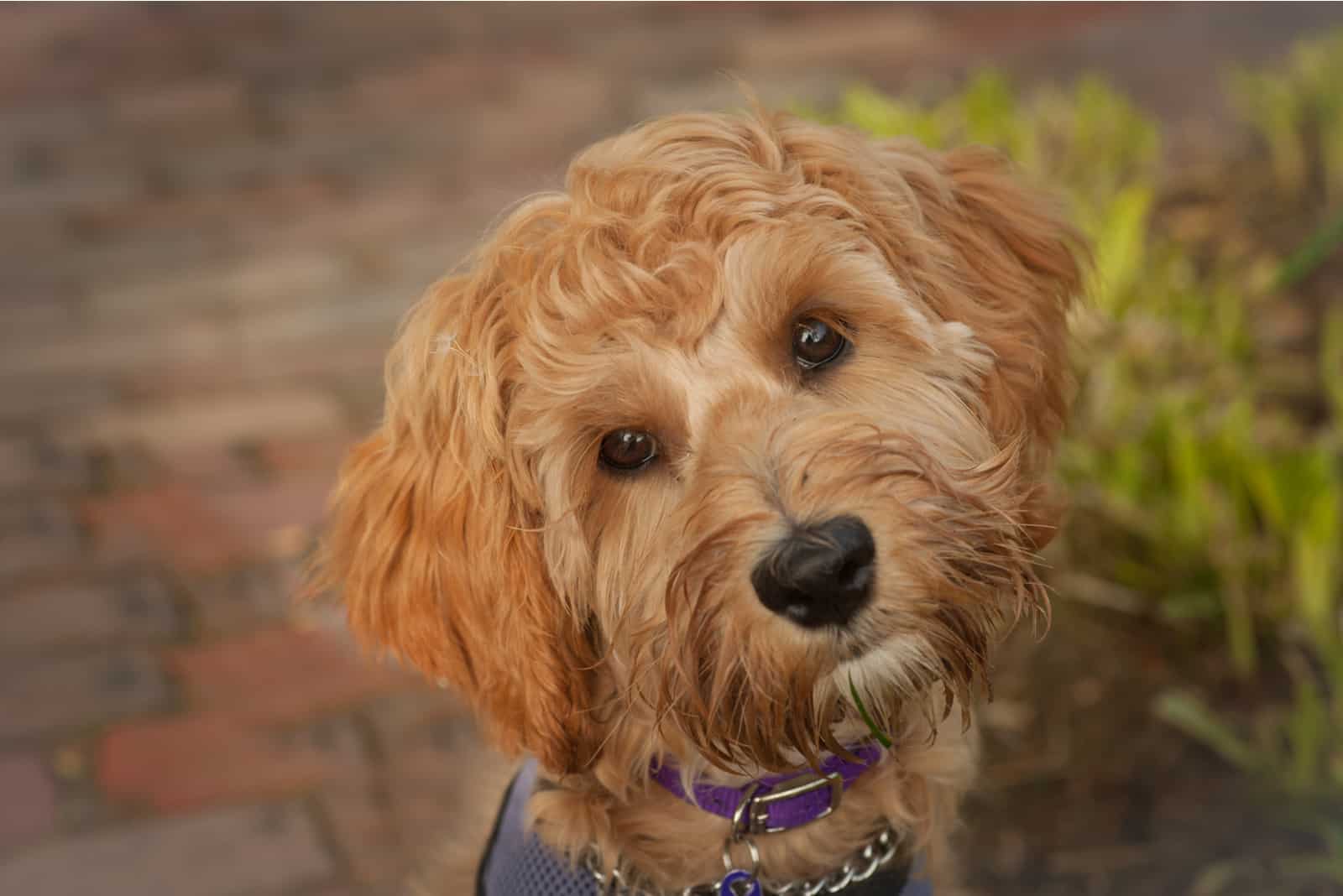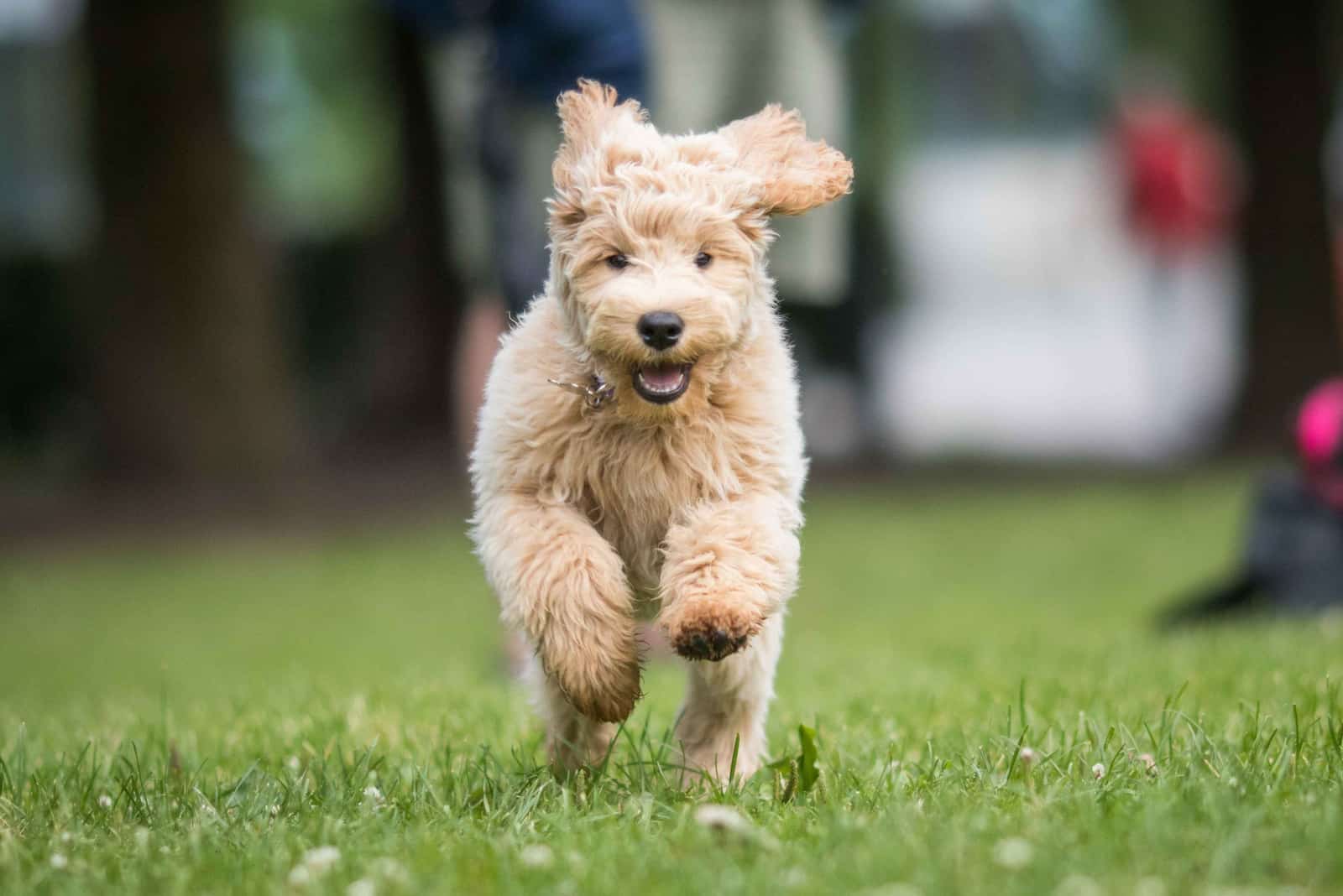Labradoodle puppy – is that a thing, you ask? Yes, indeed! In fact, labradoodles are known as one of the most popular mixed breeds in the United States. That’s exclusively due to its extremely popular parent breeds – the labrador retriever and the poodle.
The Doodle breed is quite popular among breeders and credit goes to the poodle’s exquisite physical and behavioral characteristics. This dog breed is highly favorable for crossbreeding due to its calm, intelligent, and social character.
On the other hand, the poodle coat is one of the most hypoallergenic coats among dogs and, additionally, it is subject to various grooming ideas.
When it comes to the labrador retriever breed, the American Kennel Club has registered this dog as the most popular dog in American households. The rationale for such a wide representation is found in labrador’s beautiful and calm nature, intelligence, and affection.
Labradoodle, the successor of the two, happens to collect all the best traits from its parent breeds and its appearance shows nothing but the utmost joy and happiness.
Interested in labradoodles yet? In the upcoming part of this article, find out about the labradoodle growth chart throughout the life stages!
Labradoodle Growth Chart

The puppy growth in any dog breed needs to be monitored on a daily basis, especially in the early stages of life. With supervision, you can properly detect all the pros and cons of your feeding chart, but also possible defects and health issues of your puppy.
When we refer to the growth chart of the labradoodle puppy, we are actually talking about its height and weight chart. These two represent the most reliable determinants of labradoodle growth and detect the path on which your puppy is directed.
The Labradoodle puppy has several different versions. They are based on the genetic representation of the parent breeds. Usually we talk about the f1, or f1b labradoodle puppy, which mostly means it contains 50% labrador retriever genes and 50% poodle genes.
Among labradoodle puppies, we often come across the Australian labradoodle, which is quite popular.
There are different sizes of labradoodles. We differentiate between standard labradoodles, medium labradoodles and mini (or miniature) labradoodles.
| Weight | Height |
|
|---|---|---|
| Standard labradoodle | 60-65 Ibs | 22-24 inches |
| Medium labradoodle | 30-45 Ibs | 18-20 inches |
| Miniature labradoodle | 15-25 Ibs | 13-16 inches |
A standard labradoodle is a cross between the purebred dogs: labrador retriever and the standard poodle. It is the biggest among labradoodles and its lifespan is around 12-15 years.
A Medium labradoodle represents the medium-sized cross between the labrador retriever and the medium poodle and it is somewhat smaller than the aforementioned one.
A Mini labradoodle is the smallest among the three and represents the cross between the labrador and the miniature poodle, or toy poodle.
All three come in various coats and the most popular labradoodle colors: golden, cream, apricot, or red. They have a medium-long muzzle and loose ears. Usually the labradoodle has curly hair that needs daily grooming. However, if the dog tends to go outside, the recommendation is to keep its hair short.
Now let’s see what the labradoodle growth chart looks like by age!
Labradoodle Weight Chart By Age
| Age | Age Estimated height (inches) |
|---|---|
| Week 1 | 0.5-0.7 inches |
| Week 2 | 1-1.2 inches |
| Week 3 | 1.7-2 inches |
| Week 4 | 2.5-2.7 inches |
| Week 5 | 3-4 inches |
| Week 6 | 4.5 inches |
| Week 7 | 5-6 inches |
| Week 8 | 6.5-7 inches |
| 3 months | 11-12.5 inches |
| 4 months | 16 inches |
| 5 months | 18 inches |
| 6 months | 20 inches |
| 8 months | 22.5 inches |
| 10 months | 22.5-23 inches |
| 12 months | 22-24 inches |
| 18 months | 22-24 inches |
| Adult labradoodle | 22-24 inches |
Labradoodle Height Chart By Age
| Age | Estimated height (inches) |
|---|---|
| Week 1 | 0.5-0.7 inches |
| Week 2 | 1-1.2 inches |
| Week 3 | 1.7-2 inches |
| Week 4 | 2.5-2.7 inches |
| Week 5 | 3-4 inches |
| Week 6 | 4.5 inches |
| Week 7 | 5-6 inches |
| Week 8 | 6.5-7 inches |
| 3 months | 11-12.5 inches |
| 4 months | 16 inches |
| 5 months | 18 inches |
| 6 months | 20 inches |
| 8 months | 22.5 inches |
| 10 months | 22.5-23 inches |
| 12 months | 22-24 inches |
| 18 months | 22-24 inches |
| Adult labradoodle | 22-24 inches |
A Labradoodle is a high-quality hybrid dog that you and your family are gonna love! It has an affectionate nature and the bond is created immediately. Its overall cuteness correlates with cute labradoodle names that are popular among owners, like Luna, Daisy, Ollie, and so on.
The Labradoodle growth rate significantly varies throughout the first several weeks. This is due to their unstable and unset feeding habits. Each labradoodle has its own pace from birth until the first month.
In order to present the labradoodle growth chart more clearly, we will divide it into two parts: the weight chart and the height chart.
Also, you need to know that this is the estimated growth chart and it shows the labradoodle relative growth.
Labradoodle Life Stages Explained

1-3 Weeks Old
Labradoodle puppies belong to large dog breeds. However, in the first couple of weeks, known as puppyhood, they are very fragile and need extra attention. Labrador mixes are usually healthy dogs, but sticking to the proper feeding chart is still necessary at every stage of their lives.
At this stage of life, when your puppy is miles away from its adult size, you need to make sure it stays with its dog mother. Breastfeeding is crucial for further development of your labradoodle growth chart.
It weighs around 1-3 pounds in this life stage and is around 1-2 inches tall. This is the standard size of a labradoodle puppy by the end of the third week. Sleeping makes up a big part of the day as they are still unable to move, walk, or open their eyes.
You need to make sure they get a warm, cozy cradle, without any noise. All they seek in the puppy phase is a peaceful environment and a labrador-poodle parent next to them. Labradoodle breed dogs reflect a teacup size in the puppy phase, which allows them to fit in your hand.
4-8 Weeks Old
A month old labradoodle puppy’s height is somewhere between 2.5-7 inches. This is the stage when they start crawling. They are still breastfed as their jaw is still undeveloped for any dog food intake.
This is the age where the puppy growth chart varies from time to time, as they rapidly grow. Do not be surprised if there are variations among labradoodle puppies in the same litter.
It is perfectly normal to have different growth chart representations among puppies since there might be several different labradoodle puppies genetically represented in the same litter.
The average weight at this stage of life is between 5-12.5 pounds. By the end of week 8, puppies are already on their feet with their eyes wide open. This is the time they start bonding with the owner and start playing too!
They are still far away from the full size grown labradoodle, but their external characteristics, like coat type and coat color, are starting to show. The behavior of your puppy is slowly shaping and the advice is to slowly start to implement socialization techniques as some sort of positive reinforcement.
The best way to train socialization is by rewarding them with snacks, but beware! Focus only on healthy snacks appropriate for this age, as the dogs are still considered babies.
Generally, the poodle and labrador feeding chart is strict and demands attention. Obesity and other stomach issues are not uncommon if the dogs are fed unhealthy food.
9 Weeks – 5 Months Old
This is the stage your labradoodle puppy is now several months of age old, which means the growth chart is significantly changed upwards. Do not be surprised if the puppy starts growing rapidly. This is not a small dog and its sudden growth is completely normal.
Usually, the breeders sell this puppy after 8 weeks. This is the time their feeding is normalized, the coat is recognizable and potential diseases are detected. However, you might want to be careful when purchasing a labradoodle puppy.
The labradoodle canine is popular worldwide. Make sure you research the greatest labradoodle breeders in the UK, US or any other place once you decide to buy this puppy, especially because of the bloodline and potential cons shady breeders can pull.
The average height of the puppy in these months is between 7-18 inches and they weigh around 14-45 pounds. You can see that in just three months the puppy increasingly starts to grow and now it’s a bit closer to the adult dog proportions.
Puppy weight needs to be measured daily in these months, since obesity can occur as a major problem. These doodle canines need a lot of activities even at an early age, since the character of any doodle, like the goldendoodle, is cheerful and playful.
Obesity can prevent the labradoodle canine from being active, and puppies that big will develop laziness, slow mobility and, sometimes, even anxiety.
6-10 Months Old
Six-month old labradoodles are already half-grown puppies that have established feeding chart and daily schedules. This is the period when they have already been potty and crate trained. This means you won’t have any trouble getting your dog to behave properly indoors.
Labradoodles are usually an adaptable dog breed and the indoor setup is what they are used to. Pet parents, however, need to take into consideration their high-activity level as these puppies seek at least 1-2 hours walking a day.
The average weight in these months is 45-60 pounds and their height reaches 20-23 inches. As we can conclude from the growth chart, this is the period where they almost reach their full potential and adult weight and height.
Pet parents need to adapt the feeding chart to their puppy in a way that ensures it contains the required macronutrients for proper puppy growth. Puppy’s parents are also sensitive in this regard. The best dog food for labrador retrievers and poodles is a must.
Considering their high-activity character and the fact that this is a large dog, the feeding chart needs to encompass proper protein intake. It helps a labradoodle develop strong muscles and keep their energy level within the standard.
The details of the Labradoodle growth chart depends on the food intake and can vary according to the food this puppy eats.
11-18 Months Old
Dog weight usually reaches its maximum in this phase of life. This is the case with labradoodle puppies too.
The canine now weighs around 62-65 pounds and it is 22-24 inches tall. This is the standard labradoodle size if we take into consideration the average height and weight of labradoodles worldwide. There are, however, some exceptions as some standard labradoodles resemble giant versions.
This is the trait of poodles, considering the fact that some standard poodles can reach a giant size.
At this age, this cute doodle fellow has grown dog characteristics and this relates to its hair length too. Since the poodle genes are highly represented in this breed, it means that the labradoodle also has curly, long hair that can be groomed in many ways.
Poodle haircuts are extremely popular in this regard and can be applied to this puppy too!
Adult Labradoodle
The adult phase of this canine is reached after 18 months of age. Some breeders consider the puppy an adult at 2 years. However, here we’ll only talk about its physical characteristics, as we have already seen that the puppy can reach adult size at 1 year old.
The adult phase implies other things, such as labradoodle behavior being stable and consistent, calmness, deeper barking voice, and sexual drive. That’s why it is important to neuter your puppy before it reaches adulthood, as this process is harder in the latter stages of life and dogs need more time to heal.
Adult labrador doodles will show consistency in their behavior and won’t make any unpredicted moves. However, there might be an exception if they are under stress. If you keep asking yourself ‘‘Why is my dog acting weird all of a sudden?,’’ the answer may potentially be found in anxiety.
Labradoodles do not cope with separation well. It causes them stress and anxiety which can be self-destructive. Also, lack of physical activity can frustrate your puppy, so make sure you always find new ways to entertain it.
They won’t be as active as brittany spaniels, but won’t be couch potatoes like pugs either. A balance between these two is needed.
What Impacts Labradoodle Growth Chart?

There are several factors that impact this canine’s growth chart. The most obvious is the origin of a labradoodle. It implies the size and type of dog parents and their representation in the labradoodle puppy.
For instance, labradoodles that originate from the standard poodle and labrador retriever will generally be within the standardized labradoodle growth chart.
However, if the poodle parent is a medium poodle, or miniature poodle, it means that its successor will tend to be within those proportions too.
This is not always the rule, as some canines are more inclined to the labrador retriever’s genetics.
Other factors may include their feeding habits, the amount of training they get, or potential diseases and health issues that prevent them from proper body development. The last one is not likely to happen, since both of its dog parents belong to healthiest dog breeds in the world.
Labradoodle Parent Breeds Growth Chart
Both labrador retrievers and poodles are considered as medium to large dog breeds. In f1, or f1 cross, the labrador and poodle mix will most likely be as big as its parents.
Labrador retrievers, however, may reach up to 80 pounds, but the most favorable weight for these canines is around 60-75 pounds.
On the other hand, standard poodles can go up to 70 pounds, but there are some exceptions where they even weigh 80-85 pounds. These are considered giant poodles and this type is very rare. The poodles feeding chart needs to be monitored properly, as this dog breed can also face unwanted obesity.
In the following charts we will see labrador retriever and poodle size throughout ages and how this compares to the labradoodle growth chart.
Labrador Retriever Growth Chart By Age
Labrador retrievers are known as a medium to large breed. This canine standard growth chart shows that their weight starts with no more than 7-9 pounds in weight in the first month, but it rapidly grows in the second month.
The same goes for their height. The average height of labrador retrievers in the first month reaches no more than 2.5 inches. As time goes on, they grow up to 12 inches by the end of the third month.
One thing these puppies have in common in regard to growth is that there is low, or no, increase in the growth chart once the puppies turn one year of age.
| Age | Estimated Weight | Estimated Height |
|---|---|---|
| 1 month | 7-9 Ibs | 1.5-2.5 inches |
| 3 months | 25 Ibs | 12 inches |
| 6 months | 50-60 Ibs | 18-20 inches |
| 12 months | 60-75 Ibs | 21-23 inches |
| Adultery | 70-80 Ibs | 22-24 inches |
Standard Poodle Growth Chart By Age
The standard poodle shares almost the same growth chart with labrador retrievers in the first couple of months. These canines do not exceed 5 pounds in the first month and their height reaches only 2 inches.
In the latter stages of life, the growth is rapid. We can see that, in the third month, these puppies gain at least 20 pounds and their height goes up to 12 inches.
After the first six months, the growth rate of poodles slows and has fewer changes. The same goes for the labrador retrievers and the labradoodle growth chart.
Age Estimated Weight Estimated Height
| Age | Estimated Weight | Estimated Height |
|---|---|---|
| 1 month | 2-5 Ibs | 1-2 inches |
| 3 months | 25 Ibs | 8-12 inches |
| 6 months | 45-55 Ibs | 13-19 inches |
| 12 months | 60-65 Ibs | 19-20 inches |
| Adultery | 65-70 Ibs | 20-22 inches |
Feeding

Feeding can be crucial in the labradoodle growth chart. Early development of their healthy feeding routine is crucial for proper growth. This mixed breed is active by nature and belongs to the medium sized to large dog breeds.
Usually, the large dog breeds require more food and bigger portions that are split into three even meals. The first one is taken early in the morning, since the dog was asleep for the last 7-8 hours. Their energy level in the morning will be low and needs refilling.
Once the puppy has eaten, you don’t need to feed them again until noon. Make sure the puppy gets moderate activity in between me
als, but you want to wait at least 2 hours after the food intake. Otherwise the dog can face stomach ache and won’t be able to exercise properly.
The best time for walking is before dinner. This way you allow your puppy to spend the rest of the energy from lunch and dinner to be processed easily. Always make sure the labradoodle has dinner 2-3 hours before bed time.
Junk food and the worst dog food brands on the market should be avoided at all times. They will impact the dog negatively and increase the chance of developing obesity, as well as other stomach issues, like bloat, or stomach bacteria.
Lastly, you need to make a distinction between puppyhood and adulthood when it comes to the feeding habits of your labradoodle.
The puppyhood phase requires more frequent meals and available food at all times. This is due to the puppy’s faster metabolism. The food is processed faster and the energy levels depend on the food intake.
As an adult, the dog has already established steady feeding habits. This means the energy levels are sustained easier in between meals and smaller amounts of food would suffice for the overall feeding chart of your canine.
Training
The other important determinant that goes along with your puppy’s feeding is the training process. This is common for all large dog breeds, as they require more activity in order to remain healthy.
The adult dog of this breed requires more frequent exercise for proper muscle development. Moderate muscularity prevents your puppy from dealing with joint malfunctions and weak bones. Muscles prevent bones from breaking and increase the overall training potential of a puppy.
Since the labradoodle puppy is an active dog breed, it requires moderate to high levels of activity during the day. This is an intelligent dog breed that could easily become bored by the same training techniques, so feel free to differentiate.
If, by chance, you run out of ideas, you can always search goldendoodle puppy training tips, as these two breeds have similar physical potential.
An inactive labrador-poodle mix is positively correlated with a negative growth chart. There are various forms of this irregularity, such as obesity, underweight, developing a plethora of puppy diseases, etc.
Health Problems That Impact The Labradoodle Growth Chart

This breed is considered a healthy one, taking into consideration that both of the parent breeds are two of the healthiest dogs in the world. This may have something to do with the fact that both the labrador retriever and poodle are active dogs that enjoy exercise and all types of physical activities.
However, just like any other breed, these hybrid puppies can face certain health issues. The most common related to the labrador-poodle mix are: hip dysplasia, progressive retinal atrophy, and bloat. Find out more below!
Hip Dysplasia
Hip Dysplasia in dogs is common for all large breeds. It is manifested through severe pain in the hip area and causes joint malfunction.
Puppies facing this health issue are usually unable to perform normal physical activities, such as running, jumping, or sometimes even walking.
Hip dysplasia symptoms are easily detected, since the abnormality in labradoodle behavior is obvious. Puppies can be extremely inactive, lying around the house all day, and using a weirdly manifested walk.
Some dog breeds rub the lower part of their body against the floor.
This condition impacts the overall growth chart in a way as it prevents puppies from developing the strong muscular posture needed for daily activities.
However, hip dysplasia is rarely a developed condition in the latter stages of life. It is usually inherited and genetic, so reputable breeders won’t sell you a dog with this disease.
All respected and AKC recognized breeders will provide you with a health guarantee.
Progressive Retinal Atrophy
The other health issue related to labradoodle puppies is progressive retinal atrophy (PRA), or more commonly known as dog’s blindness.
The disease is manifested through the atrophy of cells related to photoreceptors. It is a gradual disease that happens slowly, but the outcome is always the same – blindness.
There are two different types of this disease. The first is birth progressive retinal atrophy and affects puppies around 2-3 months of age. The second happens in the latter stages of life, somewhere around 5-7 years of age.
No puppies with PRA can exercise their full potential, nor can they perform normal daily activities, which negatively impacts their growth chart.
Dogs facing this condition are not supposed to be used for breeding, as the disease can be transferred to another labrador-poodle mix generation.
Bloat
Bloat is an issue that exclusively affects large breeds. The other name for this condition is gastric dilatation volvulus.
It manifests in a puppy’s stomach being filled with gas, food, or water. Puppies that have this disease can face deadly repercussions, especially if the disease is not treated timely.
Puppy weight needs to be monitored daily, as well as their feeding habits, since the bloat affects dogs that eat more food than required.
Junk food is a factor that also causes bloat. How big will a labrador-poodle mix get depends on what sort of food you give to your puppy.
However, this does not always have to be a potential threat to your labradoodle, especially if the pet belongs to medium-sized breeds. This means its overall posture is somewhat different than in other large breeds, such as german shepherds, or huskies.
The head of medium-sized dogs is more properly positioned during feeding and this prevents bloat development.
Frequently Asked Questions

1. What Is The Average Weight Of A Labradoodle?
The average weight of a labradoodle puppy is somewhere between 60-65 pounds. This is related to the standard, adult size canine that developed their full growth potential.
However, there are other versions of a labrador-poodle mix, like a teacup mini labradoodle, or a medium labradoodle. The average weight is somewhat different.
Teacup mini or, popularly called, miniature labradoodles are no more than 4-6 pounds heavy and their height does not exceed 10 inches.
On the other hand, medium-sized labradoodles weigh around 30-45 pounds, which puts them right in between mini-size and standard-size labrador-poodles.
2. Are Labradoodles Full Grown At 6 Months?
No. Generally, there are no puppies that are fully grown at this age. Six months is a period that characterizes half-grown puppies. The puppy growth chart has its own pace and all phases are equally important.
Poodle-labradors are fully developed once they exceed 18 months of age. However, some canines of this breed stop growing after one year, or even ten months.
Many labradoodle puppies reach their adult size after 12-15 months. After that, there are only a few changes in their physical appearance and the size is almost unchanged.
3. How Much Exercise Does A Labradoodle Need?
This breed is considered as an active dog breed. It means they will probably need more exercise than a standard large dog, so the pet parents should be prepared for this challenge.
The labrador-poodle mix is generally recommended for more active people, or sportspeople, since the dog enjoys long walks, hikes, and runs.
To stay in shape, both mental and physically, labradoodle canines need 1-2 hours of daily activity. You don’t want to go below that because puppies that lack activity can feel anxious.
You may wonder why your dog wants to be alone, but the answer really lies in the fact that the puppy is bored, or anxious.
Bear in mind that this is an intelligent dog breed, so the same activities over and over again won’t do the job. The dog owners need to be active and creative too!
Conclusion
The labradoodle growth chart is an important issue if you’re planning on having this canine as your life companion. It needs to be monitored and followed on a daily basis, especially because every deviation means a potential threat to your puppy’s health.
The labrador retriever and standard poodle breeds equally contribute to a large breed character of this hybrid puppy. Furthermore, their good health, hypoallergenic coat and lovely appearance are just some of many outstanding traits this canine has.
In a nutshell, these canines will melt your heart with their cute looks and affectionate nature, so make sure their growth goes as smoothly as possible!
Read more:
• Top 10 Most Responsible Labradoodle Breeders In Ontario
• 8 Reputable Mini Labradoodle Breeders In The United States
• The Labradoodle Feeding Chart And Healthy Diet Guide













